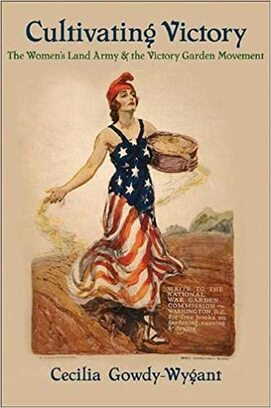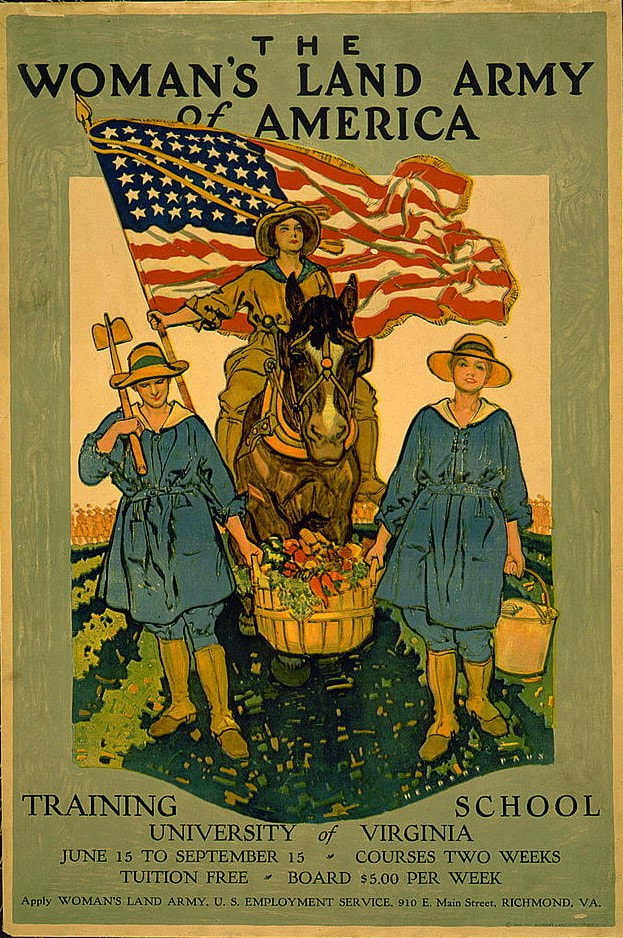|
This post contains affiliate links. If you purchase something from a link, you'll be supporting The Food Historian! The Woman's Land Army of America came out of the women's suffrage movement as a way for young, largely college-educated women to prove their worth during wartime by providing agricultural labor to make up labor shortages thanks to the draft, better wages in industrial work, and the need to increase agricultural production. The movement started in New York State, and has been ably chronicled by Elaine Weiss' book The Fruits of Victory. This beautiful propaganda poster from the University of Virginia Training School for the Woman's Land Army of America is just delightful. The imagery is evocative. A young woman holding an American flag, which billows out behind her, is dressed in a khaki uniform and riding a plow horse through a green agricultural field, simultaneously calling to mind a mounted standard bearer, Teddy Roosevelt's Rough Riders, and Army cavalry. In the foreground, two young women in matching blue uniforms share the load of a bushel basket laden with vegetables. The woman at left has a hoe over her shoulder, reminiscent of how a soldier might carry a rifle. The woman at right carries what appears to be a milk pail. Far in the background, what appears at first glance to be a field of ripe wheat is in fact a golden line of uniformed women with agricultural implements on their shoulders, marching behind the leading three. The costumes were among the official Woman's Land Army costume - in khaki and blue chambray. A loose tunic with full sleeves (rolled up) and a cinched waist falls to the knee, covering military-style jodhpurs and puttees over sensible shoes. A broad-brimmed hat and a kerchief around the neck complete the sensible outfit, which somehow still scandalized some members of the public at a time when women's skirts rarely rose above the ankle. The poster is advertising the Woman's Land Army's Training School at the University of Virginia. Designed to give young women basic agricultural skills, and sometimes specialized skills like the use of tractors, the schools were generally free, but required payment for room and board, as this one does at $5.00 per week for a two week course. Sometimes called "farmerettes," likely a combination of the terms "farmer" and "suffragette," and one which not every member of the Woman's Land Army enjoyed. But then, not every farmerette was a member of the Woman's Land Army, and the term actually predated the U.S. entrance into the war. The women saw some success in the adoption of their labor in agriculture, but it created no sea change of labor distribution post-war. Most farmers outside orchards and truck farmers mechanized in the face of labor shortages, rather than using farmerettes or farm cadets (teenaged boys released from school to work on farms). And increasing specialization of crops and livestock meant that mechanization was easier and more profitable than hiring young women at good wages for just 8 hour days (pre-war farm laborers had no such protections). The Land Army would be revived during World War II, this time divorced from its suffragist origins and encouraging young people of both sexes to assist with farm labor. But that's a post for another day. Woman's Land Army Books Fruits of Victory: The Woman's Land Army of America in the Great War by Elaine F. Weiss Weiss tracks the evolution of the Woman's Land Army in America, focused primarily on New York State, which was where the WLA officially began in the U.S. In intimate detail, she introduces us to a whole host of historic characters, including leading lights of the women's suffrage movement, and how they tried to prove women's agricultural labor was the future.  Cultivating Victory: The Women's Land Army and the Victory Garden Movement by Cecilia Gowdy-Wygant Cultivating Victory examines the interrelationships between the British and American Woman's Land Armies, as well as their connections to the war garden and victory garden movements. Covering both the First and Second World Wars, Gowdy-Wygant compares and contrasts the efforts in both nations and the differences and similarities between both wars. The Food Historian blog is supported by patrons on Patreon! Patrons help keep blog posts like this one free and available to the public. Join us for awesome members-only content like free digitized cookbooks from my personal collection, e-newsletter, and even snail mail from time to time! Join by June 30, 2020 and get a picnic history packet mailed to your door!
0 Comments
|
AuthorSarah Wassberg Johnson has an MA in Public History from the University at Albany and studies early 20th century food history. Archives
July 2024
Categories
All
|


 RSS Feed
RSS Feed